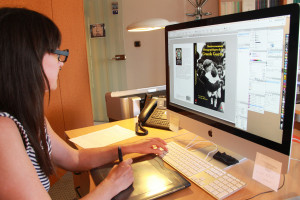Nicole Berthoux, graphic designer
working in INED’s publishing department

What trajectory led you to INED?
I began my career at INED in the graphic design section of the publishing department. But I had applied for a completely different job. After studying photoengraving and printing, I’d worked doing layout in a design agency. Then in summer 1986 I was looking for a job and I learned that INED was hiring coders for a few months to enter survey data. I was lucky: after reading my training and job experience, the head of the survey office immediately took my CV to the publishing department, which was looking for someone to do maps and figures. At the time, INED researchers drew figures in pencil on graph paper and the drawing office fixed them up for printing. We worked with ink and a drawing pen, and with pasted-on map outlines. I remember the first figure I did, which illustrated variation in births by season, month, hour and even lunar phase. The researcher had demonstrated that, contrary to old beliefs, the moon had no influence on births!
What is your current job at INED?
I still work in the publishing department, but it’s hardly the same job! First, because I’ve switched from the drawing table to a graphics tablet; second, because I do books from start to finish now: computer graphics, page layout, digital mockup and the cover. I also follow the book production process, which gives me an opportunity to use my training in printing. When you master the entire chain of steps it increases your maneuvering room. Using this applied art in the service of scientific production requires care and attentiveness, also exchanging with the authors, for example, suggesting graphic representations that are easier to read. You have to find the best-adapted form, and not all demographic studies are simple to illustrate. Over the years, I’ve been able to participate in the modernization of INED publishing. We have been moving toward turning out really nicely finished products. We had to convince the decision-makers that a scientific work was first of all a book. And we had to “attack” a few venerable “institutions.” In 1998 I was asked to retouch the cover of Population, the Institute’s emblematic journal, which had not been redesigned since it was found in 1946. Through our covers and layouts, we’ve tried to give a strong identity to INED’s different series, from the Cahiers to the Grandes Enquêtes [major surveys].
What do you appreciate at INED?
In addition to the people I’ve met and relationships I’ve formed at INED, I appreciate the great variety in my work—it’s always changing. Today I’m learning digital publishing. There are always new projects—and a great deal of freedom and independence for carrying them out. And it’s always very satisfying to finally hold in your hands a new book you’ve worked on for weeks, not to mention when a researcher at a book fair tells you they’d like to publish in an INED series because it’s elegant!
